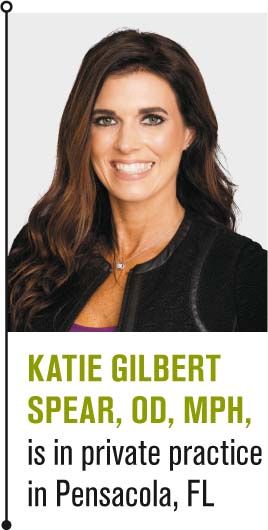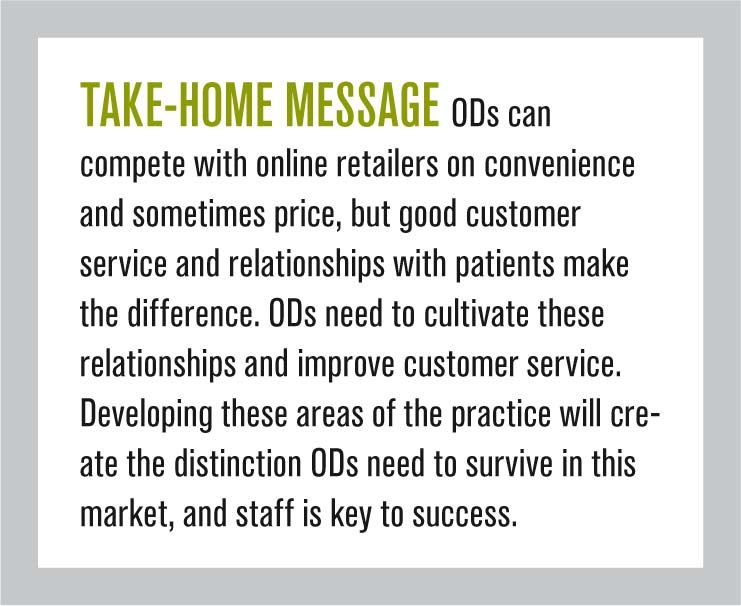How staff can help differentiate your practice
Online sales aren’t going away. ODs and their staffs are able to match price and convenience, but they excel at outstanding customer service. One OD outlines how she adopted an innovative service process in her practices to improve relationships with patients.



The many changes that online optical retailing and now online “eye exams” create for optometry practices can cause ODs to worry about their futures. Will the improvement in technology make us obsolete? How do we combat these changes and stay relevant in this ever-changing market?
Convenience and price
To answer this, we must first look at why patients want to buy glasses and contact lenses online. There are many reasons, but two of the most common are convenience and price.
As private practitioners, ODs may or may not be able to compete on price, but I don’t know that we want to try. In our offices, we refuse to provide cheap products and materials. We want our patients to have the best-just like we want for ourselves, our families, and our staff.
Related: Why it’s important to have a marketing plan
ODs are able to offer convenient ordering to compete against onlinesales. For example, the patient is already in your office-if we make the purchase process enjoyable and easy, then it is just as convenient for the patient to buy from us as to buy online a few days later. Often patients cite cost as a barrier to purchase, but many times patients have vision care plans that contribute to their purchases. Yet they still go online to buy. I believe it is ODs’ processes and presentations that hinder patients from buying from us. ODs and staff do not educate patients on the differences between what we sell and what is sold online.
Customer service important
We have established that ODs are able to compete on convenience and sometimes price, but we prevail-as compared to online retailers-with customer service and relationships with our patients. ODs must cultivate these relationships and improve customer service. Developing these areas of the practice will create the distinction ODs need to survive in this market, and staff is key to success.
We are able to create distinction within our offices so patients do not want to go online to get an “eye exam” or purchase glasses and contact lenses. We create distinction by being different, and this is achieved by creating an experience that shows patients how we are different.
Related: 5 steps to maximize your optical profit
Many times patients do not know the difference between an online “eye exam” and the comprehensive exams ODs perform. This disconnect occurs because ODs rarely explain to them what we do or why and what critical information these tests provide. Many patients also do not know the difference in the frames and lenses available in the optical vs. the pair purchased online.
Patients have problems, and ODs offer solutions. However, frequently ODs simply fail to educate patients on how we can provide these solutions.
A service example
While pondering this problem of creating distinction, I visited my hometown of Tuscumbia, AL, and toured the office of good friend Barry Basden, OD. He has an amazing operation of five offices in northwest Alabama. In his offices, team members stay with the patient throughout the exam from check-in to check-out.
I was amazed at how efficient and productive his staff was in guiding the patient through the exam and office. I went back to our offices and realized this was what we were missing. No online retailer can compete with global customer service. This model provides patients with an advocate in the office-when they rip a contact lens or break their glasses, they have someone to call. Patients also have a personal shopper, someone who knows their vision and health concerns and can utilize the doctor’s recommendations to solve these problems.
Consider this from a patient’s point of view. Who wouldn’t want such an advocate at her doctor’s office?
Taking the idea back
The idea was great, and I saw how it worked in Dr. Basden’s offices. However, I was not so sure it would work in ours. After discussing the challenges with my office managers, we decided to give it a try. Once we were committed to implementing this process, we came up with a plan.
One of the most important-if not the most important-aspect of this system is educating and training your team. You cannot educate your patients without an educated team. Your team needs to know why they perform certain tests on patients and what information this gives the doctor. As they are performing the tests, they should communicate this to the patient.
Your staff needs to know which questions are important to ask in order to elicit complaints that could help the doctor when prescribing multiple pairs of glasses and lenses. Along with this is understanding strategies for products in your office. Once staff take a history and identify a patient’s concerns, they are able to start recommendations.
For example, in our office we have a contact lens flowchart based on a patient’s needs and prescription. My team is trained on this flowchart, and once they uncover a patient’s complaint or identify how the patient wants to wear contact lenses, they can easily start educating the patient on what is new with contact lenses and what solves are available. Once they relay this information to me, I can prescribe the best contact lenses to solve the patient’s problem.
Making it work
To train your team correctly, you need a well-developed plan. Our team’s education and training took a few months, which can seem like a long to time to someone who is impatient like me. However, this part was very critical to the process, so it was worth the wait.
Related: Why ODs need a business strategy
We began by having an after-hours meeting to review why we were making the change and what processes we needed. We laid out the plan to the team and discussed challenges and answered any questions. Over the next few weeks, we cross-trained one team member at a time to another position. For example, if a team member was a technician, we cross-trained him in the optical. When a technician or optical team member was not busy, they shadowed someone in another area of the office. This continued for several months.
We also conducted a few in-depth training sessions at night and even closed the office for an afternoon to train. I know what you are thinking: “If I close my office, I will lose money.” Consider it an investment; the amount you lose that afternoon will be repaid multiple times over once this process is implemented.
Patients come first
Overall, it took a few months to fully implement the entire process. We have had some challenges, but the gains far outweigh the challenges. I knew it was the best thing we had done when I received call from a long-time patient.
She called just to tell me she loved what we were doing. When I asked what she meant, she said she could not say what was different, but she knew something was better than it was before.
Related: Learning how to manage scared noncompliant patients
As for our sales, our capture rate has increased steadily since implementing this process. Our sales of premium lenses and other products have increased, too.
However, the best part is knowing the change we are making in our patients’ lives. Doctors and staff in our offices know why patients should purchase from us. We are our patients’ advocates. We sell them exactly what they need, and when there is a problem we will fix it. With this process, patients know this as well.
Our industry is changing, and technology is not going away-in fact, it will continue to increase and improve. Technology is great, and we must utilize it in our practices to create a better patient experience. However, our relationships with patients and the customer service we provide can never be replaced with online technology.

Newsletter
Want more insights like this? Subscribe to Optometry Times and get clinical pearls and practice tips delivered straight to your inbox.